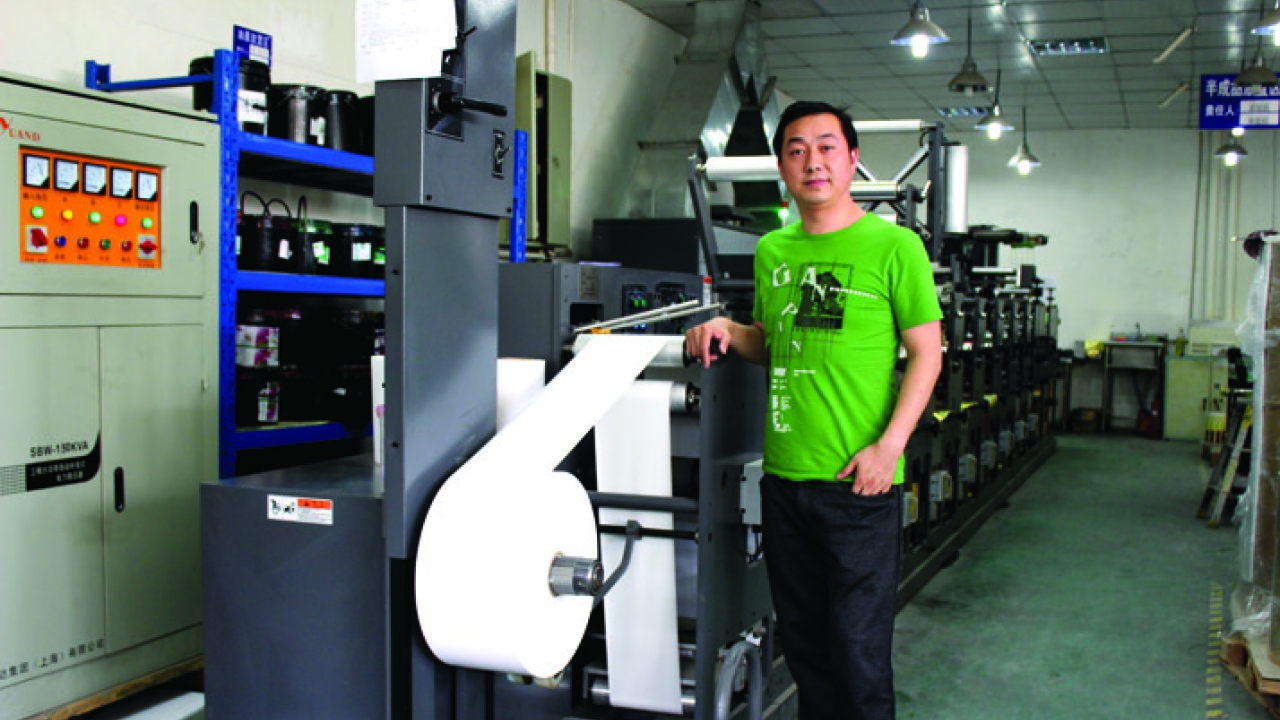Flexo springtime in China?

The acceptance of flexo printing in the Chinese package print industry has taken another step forward, as Kevin Liu reports
Flexo printing is still at a relatively early stage of development in the overall mix of package printing processes in China. In labels, letterpress and offset remain strong and in package printing sheet offset and gravure still predominate. At the same time, in Europe and the US, flexography has become the dominant package printing process.
Although the manufacturers of flexo printing presses never stop promoting their equipment, most package print converters still take a wait-and-see attitude, fluctuating between hesitation and negative opinions.
So, a key question: is flexo printing appropriate for the Chinese package printing market? Does such technology have future prospects in China?
For this reason it was interesting for L&L China to cover the installation of two Gidue UV flexo presses at a converting house in Suzhou.
Jantan: early success
In March 2012, during a warm springtime that sees everything arising with a new life, news came from a key center of the Chinese package printing industry that Italian machinery manufacturer Gidue made another significant installation.
The company completed the installation and commissioning of two flexo machines within one week: for Suzhou Jantan Packaging and Printing Limited Company ('Jantan') and Suzhou Tianjie Printing Limited Company ('Tianjie'). They were up and running in a very short time.
Jantan, is a model enterprise in the Chinese package printing market, visited by this correspondent twice before. It was established in 1992 at a plant located in Wujiang city, Suzhou, close to Shanghai. Now it has become one of the largest professional label and packaging print converters in East China area.
Jantan is an old supporter of flexo printing technology. The company used to import Gallus flexo machines quite some time ago. At that time, after extensive investigations, the managers of Jantan affirmed that flexo printing was superior to relief printing and offset print in many aspects - hence Jantan became one of the first enterprises to enter the flexo printing market. In 2008, Jantan decided to import more flexo machines. They chose an 11-color Gidue E-Combat machine – the first machine installed in China installed by this Italian company.
Although seen by many as an ‘adventure’, it has brought benefits including better performance and an increase of business for Jantan. Soon the original flexo machine could not meet the increasing business demands of Jantan. In 2010, they decided to purchase more flexo machines, and the second Gidue was installed, a 12-color combat M5 flexo. These two Gidue presses are running continuously 24hrs a day.
Two years later, Jantan imported the third Gidue flexo machine, a Combat M1-370 10-color flexo UV press. In order to increase the efficiency of the machine, Jantan equipped the M1-370 with processing units including on-line IR, cold foil, die cutting, stripping and waste removal, so all the processing steps can be finished in one pass.
The new Gidue Combat flexo press was installed in the new plant of Jantan in Wujiang Economic Development Area. Together with the previous Gallus 8-color flexo machine and two Gidue presses, they compose a powerful flexo printing workshop. Today, Jantan maintains a comparatively high market share in the sectors including chemicals, foods, health and beauty and electronics.
Growing force
Unlike Jantan, which has already learned to control the power of flexo printing, this is the first time Tianjie has imported a flexo machine. However they did not start from a low base point. Tianjie imported from the beginning one of Gidue’s most highly specified presses – an M5-370 11-color flexo press, containing 10 flexo printing units, one intaglio unit and two on-line process units including cold foil, die cutting, waste discharging, stripping, laminating, and the ability to turn the web. This highly advanced, integrated converting line greatly increased the production of printed packaging in the high-end cosmetics sector.
Interestingly, the plant of Tianjie is not far from that of Jantan, which is also located in the Suzhou Industrial Park. Before the installation of its flexo machines, Tianjie owned more than one imported press –intermittent and full rotary letterpress machines and high-precision roll to roll screen machines.
In the arena of cosmetic and electronics labels and packaging, Tianjie has abundant experience and is a long term partner of many famous enterprises including L'Oreal, Canon and Tianmei Cosmetic.
According to general manager of Gidue China, Mr. Fan Simin, ‘for many knowledge about flexo printing is very rare. Actually, current flexo printing technology has huge advantages in the printing quality and speed as well as on-line processing. At the beginning of our contact with Tianjie, they were suspicious whether a Gidue machine could assure high printing quality and overprinting precision consistently during high speed printing at 180m/min or not. They were questioning, could overprinting precision be controlled within 0.1mm? Could the on-line die cutting be precise under high speed printing? In case of a sudden malfunction, how long would it take to solve?”’
However, such questions disappeared at the time the machinery was commissioned. Mr. Fan said that during this process, when Tianjie press operators saw the print rollers turning and paper going slowly through the machine, they were interested to see how this would affect makeready time and waste. When the operation speed of the machine increased from 80m/min to 180m/min while the overprinting precision remained the same, both the managers and operators of Tianjie were smiling with satisfaction.
After the commissioning, Tianjie’s factory manager, Mr. Yang praised the efficiency of Gidue, ‘Gidue finished the machinery installation and commissioning as well as training of our operators within merely one week. This time, they really changed our views of flexo printing. The Gidue flexo machines are highly automatic. During printing, we need not adjust the pressure or stop the machine to change plate registration, because these adjustments are realized automatically. This not only assured the precision of overprinting but makes the printing itself simple, highly efficient and more consistent. After training, our operators could grasp the operation skills required and we could put them into production immediately – much earlier than we expected.’
The person responsible for direct production at the Tianjie workshop, also called Mr. Fan, said, ‘Gidue has moved really efficiently and the machine has good quality. Our printing speed can achieve up to 180m/min. On this basis, we estimate that our yield could be double this year.’
Flexo lessons
Let’s see the why flexo printing has such a high performance, from several aspects. To take the Gidue flexo press as an example, each printing unit is controlled by a full servo motor. There is no traditional driving axis so the machine runs more steadily without vibration, which increases the precision of overprinting and quality of printing. At the same time, Gidue equips its machines with an automated tracking system, which controls the processing precision of both printing unit and die cutting unit within 0.1mm.
In addition, the Gidue flexo press can storage job data and read it back when the same product needs to be produced again, when the machine automatically adjusts itself to the status of the last production job. It is very simple and the operator feels it to be both convenient and easy.
Potential malfunctions are handled by remote diagnostics via the internet – as if the senior engineer in Italy is sitting on site.
These are common advantages of modern flexo printing equipment, and as the example of these two Gidue flexo machines shows, the springtime of flexo in the Chinese package printing industry could well be arriving.
Pictured: The GM of Chengdu Tiantian Yong, Mr Yan Thianhu
This article was published in Labels & Labeling issue 1, 2013
Stay up to date
Subscribe to the free Label News newsletter and receive the latest content every week. We'll never share your email address.


